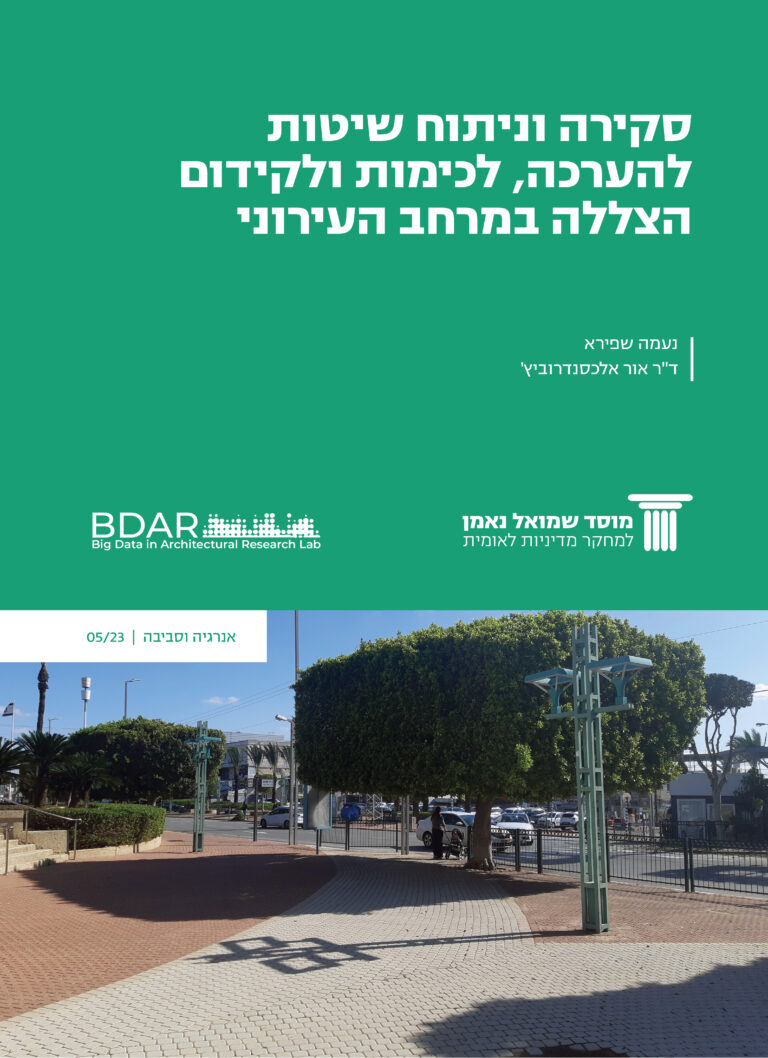Promoting street shade using trees, as a key component of Israel’s global warming adaptation strategy, lies at the heart of Government Resolution 1022 from January 23, 2022. However, the National Strategic Plan for Shading and Cooling Urban Spaces Using Trees, published following the resolution at the end of 2022, already acknowledged the methodological difficulties inherent in implementing the government’s resolution. The plan did not present an established scientific methodology for determining urban shade and forestry goals, nor did it define the mapping needs arising from such goals. In their absence, all parties involved in promoting the resolution would struggle to efficiently and effectively implement the planting of shade trees in Israeli cities, monitor progress, and allocate resources where they are most needed.
This study examined through the analysis of official legislative and policy documents to what extent planning authorities in Israel and abroad apply systematic methodologies for analysing urban shade and enhancing public accessibility to it. We were particularly interested in determining how far the policy on urban shade, as reflected in these documents, is based on quantitative indices. The study revealed that while various programs from the last decade acknowledged the importance of urban shade for mitigating heat stress and preventing skin cancer, these programs usually did not have clear quantitative definitions of shading or urban forestry goals. Even when shade is quantitatively addressed, this is often done only in the form of neighbourhood- or urban-level tree canopy cover ratio. Documents that did specify a higher-resolution quantitative index (for example, for playgrounds) referred only to the cumulative horizontal area of the shading elements, almost always without considering the variance in solar radiation intensities or the sun’s changing position during daytime. Another type of quantitative indices relates to planting distances of shade trees without direct reference to tree canopy size or the location and size of the shaded area the canopy creates on the ground.
The analysis of the reviewed documents revealed several key points that are not sufficiently addressed, as follows:
- The relatively common use of an urban canopy cover index, where a single value is supposed to represent the state of the urban forest in the entire city, does not reveal the spatial variance of tree distribution and allocation across a city.
- Setting a required tree canopy cover ratio in a given space or on a street without considering shade continuity or the changing shade patterns during daytime and between seasons may result in design solutions of limited effectiveness.
- Most of the reviewed policy documents do not specify how exactly shade ratio is calculated. Frequently, shade means merely the projection area of the horizontal component of a shading element on a horizontal surface, but this is not a realistic evaluation of the actual shaded area it produces.
- The assumption that a shading element completely blocks direct solar radiation is often inaccurate. Methods for calculating shade area ignore this and treat shading elements through which the solar radiation penetration rate may significantly differ as equal.
- Since the shading pattern changes from hour to hour and from season to season, a broad definition of a reference time (for example, 15:00-11:00 between April and September) does not take into account the significant differences between the position of the sun in the sky and the radiation intensities in these months.
The study also revealed that in Israel, there are mandatory guidelines only for shading in specified spaces, particularly in educational institutions, playgrounds, swimming pools, and bathing beaches, intending to protect vulnerable populations in areas with significant exposure to the sun. However, even the most recent and detailed regulations on the subject, which address playground shading, do not clearly answer how shading should be implemented. The regulations focus on shade provision of play facilities and ignore the shading of the nearby seating and resting areas or the access paths to the playground and its facilities. In practice, there are no mandatory shade guidelines in Israel that apply to streets and open public spaces, and no adequate response has been given to ensure the improvement of thermal comfort in public spaces in Israeli cities during the hot season.
This document is part of a study that aims to provide a quantitative, data-driven, and uniform framework for mapping, evaluating, and directing actions to promote shading in the urban environment. The researchers would like to thank Yad Hanadiv for funding the study and Ella Barzani from the Samuel Neaman Institute for helping locate relevant sources of information.












